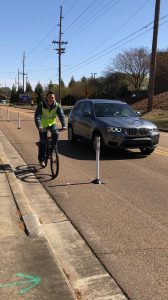
The pop-up project along Gertrude Ford Boulevard is intended to increase awareness of the road’s bike lanes, slow down traffic and increase safety in the area. Submitted photo
OXFORD, Miss. – The University of Mississippi Active Transportation Advisory Committee, Oxford Pathways Commission and the UM Green Fund Committee have temporarily reconfigured a portion of Gertrude Ford Boulevard to gather data on how to increase cyclist, pedestrian and motorist safety in the area.
The limited-time demonstration, or “pop-up” project, increases visibility of the bike lane and crosswalks using temporary road modifications that have been shown to be effective in calming traffic. Committee members will collect speed data and community feedback to inform future planning decisions.
“Projects like the Gertrude Ford Boulevard installation offer opportunities for valuable collaboration between decision-makers both with the city and university, while also elevating the input of community members who use this road every day,” said Kendall McDonald, project manager in the university’s Office of Sustainability and chair of the Active Transportation Advisory Committee. “Ultimately, the purpose of this project is to make this road safer and more accessible for all modes of transportation.”
The project is installed on a 2,063-foot portion of Gertrude Ford that spans from the crosswalk at Alumni Drive to Manning Way. This area was selected because recent speed data indicated that a majority of vehicles on this stretch were traveling above the speed limit of 30 miles per hour, and also because of heavy pedestrian traffic.
The Depot Trail ends in this area, and the Ford Center parking lot, which is zoned for commuter students, ensures heavy foot traffic.
“Gertrude Ford is an area of town that has been on the Pathways Commission’s radar for a while since it gets a lot of traffic, both on foot and by car,” said Don Feitel, a member of the Pathways Commission. “It is the perfect spot to test different traffic designs to see which elements help to keep things flowing at safe speeds.
“We appreciate that our city leaders are willing to work with its citizens to test out different methods for making our roads safe for all users.”
Phase one of this project was the installation of reflective delineators along the bike lane. Phase two will include the placement of more crosswalk signage and informative signage explaining the project and providing an opportunity for users of the road to leave feedback.
“I think that temporary projects, such as this, help community leaders make informed decisions about improving our roadways for all users,” said Kate Kellum, chair of the Pathways Commission, member of the Active Transportation Advisory Committee and associate director for Institutional Planning and Effectiveness.
This pop-up project is the second of its kind in Oxford. In 2016, the Active Transportation Advisory Committee and Pathways Commission reconfigured a portion of University Avenue to demonstrate a street designed for all users. Components of the 2016 project are incorporated into the street design on University Avenue.
“Citizen-led initiatives are happening all over the country with great success,” Feitel said. “Using temporary materials means that we can easily test various treatments and see which works best before anything is permanently installed. It brings a flexibility to the process that the city might not otherwise have.”
The Gertrude Ford project is funded by the UM Green Fund, a fund available to support sustainability-related project proposed by Ole Miss students, faculty and staff.
To learn more about the project or to leave feedback, visit http://sustain.olemiss.edu.